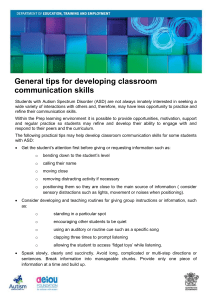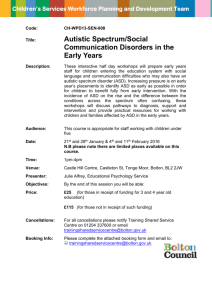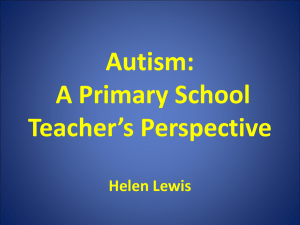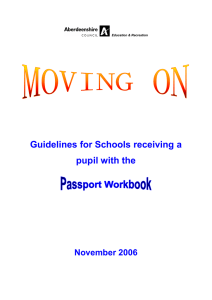The Effectiveness of Social Stories with Visual Cues for the... Inclusion of Children with Autistic Spectrum Disorder (ASD) in Primary...
advertisement
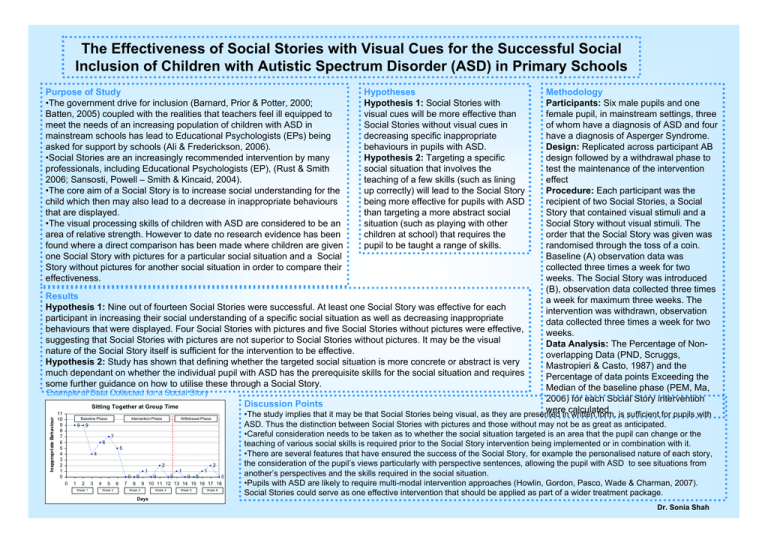
The Effectiveness of Social Stories with Visual Cues for the Successful Social Inclusion of Children with Autistic Spectrum Disorder (ASD) in Primary Schools Purpose of Study •The government drive for inclusion (Barnard, Prior & Potter, 2000; Batten, 2005) coupled with the realities that teachers feel ill equipped to meet the needs of an increasing population of children with ASD in mainstream schools has lead to Educational Psychologists (EPs) being asked for support by schools (Ali & Frederickson, 2006). •Social Stories are an increasingly recommended intervention by many professionals, including Educational Psychologists (EP), (Rust & Smith 2006; Sansosti, Powell – Smith & Kincaid, 2004). •The core aim of a Social Story is to increase social understanding for the child which then may also lead to a decrease in inappropriate behaviours that are displayed. •The visual processing skills of children with ASD are considered to be an area of relative strength. However to date no research evidence has been found where a direct comparison has been made where children are given one Social Story with pictures for a particular social situation and a Social Story without pictures for another social situation in order to compare their effectiveness. Hypotheses Hypothesis 1: Social Stories with visual cues will be more effective than Social Stories without visual cues in decreasing specific inappropriate behaviours in pupils with ASD. Hypothesis 2: Targeting a specific social situation that involves the teaching of a few skills (such as lining up correctly) will lead to the Social Story being more effective for pupils with ASD than targeting a more abstract social situation (such as playing with other children at school) that requires the pupil to be taught a range of skills. Results Hypothesis 1: Nine out of fourteen Social Stories were successful. At least one Social Story was effective for each participant in increasing their social understanding of a specific social situation as well as decreasing inappropriate behaviours that were displayed. Four Social Stories with pictures and five Social Stories without pictures were effective, suggesting that Social Stories with pictures are not superior to Social Stories without pictures. It may be the visual nature of the Social Story itself is sufficient for the intervention to be effective. Hypothesis 2: Study has shown that defining whether the targeted social situation is more concrete or abstract is very much dependant on whether the individual pupil with ASD has the prerequisite skills for the social situation and requires some further guidance on how to utilise these through a Social Story. Example of Data Collected for a Social Story Discussion Points Inappropriate Behaviour Sitting Together at Group Time 11 10 9 8 7 6 5 4 3 2 1 0 Baseline Phase 9 Intervention Phase Withdrawal Phase 9 7 6 5 4 2 2 1 1 0 0 0 0 0 9 10 11 12 13 14 15 16 17 18 1 0 0 1 2 Week 1 3 4 5 Week 2 6 7 0 8 Week 3 Week 4 Week 5 Week 6 Methodology Participants: Six male pupils and one female pupil, in mainstream settings, three of whom have a diagnosis of ASD and four have a diagnosis of Asperger Syndrome. Design: Replicated across participant AB design followed by a withdrawal phase to test the maintenance of the intervention effect Procedure: Each participant was the recipient of two Social Stories, a Social Story that contained visual stimuli and a Social Story without visual stimuli. The order that the Social Story was given was randomised through the toss of a coin. Baseline (A) observation data was collected three times a week for two weeks. The Social Story was introduced (B), observation data collected three times a week for maximum three weeks. The intervention was withdrawn, observation data collected three times a week for two weeks. Data Analysis: The Percentage of Nonoverlapping Data (PND, Scruggs, Mastropieri & Casto, 1987) and the Percentage of data points Exceeding the Median of the baseline phase (PEM, Ma, 2006) for each Social Story intervention were calculated. •The study implies that it may be that Social Stories being visual, as they are presented in written form, is sufficient for pupils with ASD. Thus the distinction between Social Stories with pictures and those without may not be as great as anticipated. •Careful consideration needs to be taken as to whether the social situation targeted is an area that the pupil can change or the teaching of various social skills is required prior to the Social Story intervention being implemented or in combination with it. •There are several features that have ensured the success of the Social Story, for example the personalised nature of each story, the consideration of the pupil’s views particularly with perspective sentences, allowing the pupil with ASD to see situations from another’s perspectives and the skills required in the social situation. •Pupils with ASD are likely to require multi-modal intervention approaches (Howlin, Gordon, Pasco, Wade & Charman, 2007). Social Stories could serve as one effective intervention that should be applied as part of a wider treatment package. Days Dr. Sonia Shah



